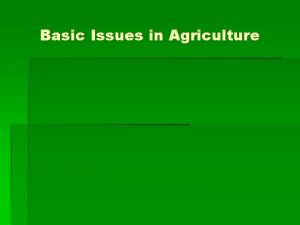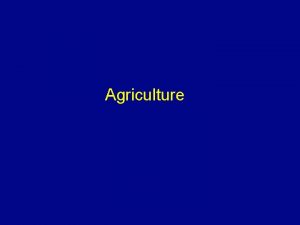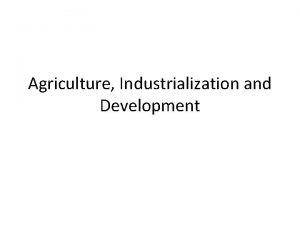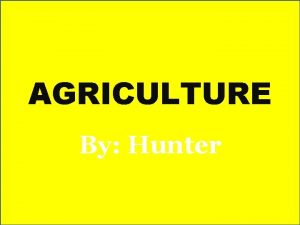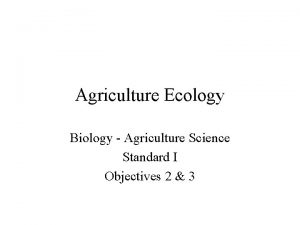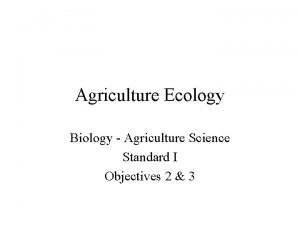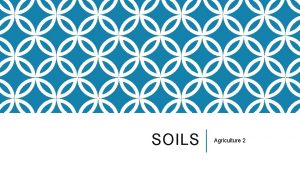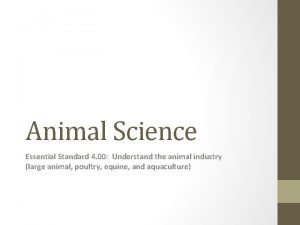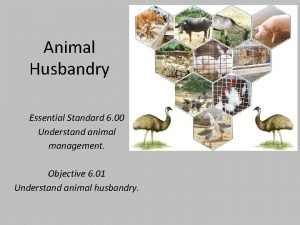Agriculture Engineering Essential Standard 6 00 Understand the



































- Slides: 35

Agriculture Engineering Essential Standard 6. 00: Understand the agricultural engineering industry.

Objective 6. 01 • Remember careers in agricultural engineering.

Agricultural Engineering Industry • Agricultural mechanics • • • Design Operation Maintenance Service Selling and Use of power machinery, equipment, structures and utilities in agriculture

Examples of Careers in Agricultural Engineering • Agricultural Electrification, Power and Controls • Electrician • Safety technician • Electrical engineer • Agricultural Power Machinery • • • Farm or heavy equipment diesel mechanic Parts person Equipment salesperson Small engine mechanic Large machinery operator (ie. bulldozer)

Examples of Careers in Agricultural Engineering • Soil and Water Engineering • Soil Conservation technician • Irrigation Engineer • Agricultural Mechanics, Construction, and Maintenance Skills • Construction worker • Welder • Safety specialist

Examples of Careers in Agricultural Engineering • Agricultural Structures, Equipment, and Facilities • • Construction supervisor Farmstead planner Greenhouse builder CAD engineer

Objective 6. 02 • Understand basic agricultural engineering principles and practices.

Shop Safety Awareness and Principles for Safety • Of all farm related accidents, nearly 50% involve working with machinery. • Safety • Developing an environment free from danger, risk or injury. • Keys to shop: • • Trained in safe and proper tool operations Pass a safety test prior to using the shop Keep the shop clean Remove unnecessary hazards such • oily rags • Make sure all machines have safety shields in place

Shop Safety Awareness and Principles for Safety • Wear appropriate personal protective clothing and devices. For example: • Safety glasses or goggles • Leather steel-toed shoes • Ear protection (plugs or muffs) • hearing loss when the noise level exceeds 90 d. B (decibels) • Other safety clothing may be required for certain work such as welding

Safety Color Coding in the Agricultural Mechanics Shop • National organizations worked together to develop the system • The American Society of Agricultural Engineers and the Safety Committee of the American Vocational Association • alerts people to dangers and hazards • provides information to help on react quickly in an emergency • conveys a special message based on a standard code

Basic Safety Code Colors • RED • Identifies areas of danger • Red is used on safety switches and fire extinguishers • Red = Danger

Basic Safety Code Colors • ORANGE • Designates machine hazards, such as edges and openings • It is also used as background for electrical switches, levers and controls • Orange = Warning.

Basic Safety Code Colors • YELLOW • Identifies wheels, levers, and knobs • adjust or control machines • Yellow = Caution

Basic Safety Code Colors • BLUE • Used on signs such as “Out of Order” • identify broken shop equipment that does not work or does not work properly • Blue = Information

Basic Safety Code Colors • GREEN • Indicates the presence of first aid and safety equipment • Green = Safety

Fire Hazards in the Agricultural Mechanics Shop • Fire Triangle • Components necessary for a fire • Fuel – Any combustible material that will burn • Examples: oily rags, sawdust, paper, etc. • Heat – Most materials burn if they are made hot enough • Oxygen (O) – Not a fuel, but must be present for fuels to burn

Fire Hazards in the Agricultural Mechanics Shop • Fire Prevention • Take away one of the components of the fire triangle and fire will not start or will stop if already started. • Safe storage of fuels or combustible materials • Store fuels in approved containers • Clean shop facilities

Extinguishing Fires • Fire Extinguishers • Know the kind of fire extinguisher • Class A Fire Extinguishers use water to control ordinary combustibles • Know the placement of fire extinguishers so that time is not taken looking for the extinguisher if a fire occurs. • hung on walls within easy reach in areas where fires would most likely occur • Know how to use • held upright, the ring pin is pulled, and a lever is pressed • nozzle of the extinguisher toward the base of the fire

Extinguishing Fires • Other examples • Wrapping a person in a blanket whose clothes are on fire • eliminates oxygen from getting to the fire • Cooling with water from a hose or bucket a burning container of paper

Planning an Agricultural Engineering Project • Simple Project Designs • • • Sharp lead pencil Protractor for drawing and measuring angles Good eraser for making corrections A twelve-inch ruler Compass for drawing circles and arches

Planning an Agricultural Engineering Project • More Detailed Plans • Drawing board • Masking • The T square • drawing horizontal lines • The right triangle (30, 60, 90 degree triangle) in conjunction with the T square, is used to draw vertical lines. • The scale • Instrument with all increments shortened according to proportion • Flat scale – looks similar to a ruler. • Triangular scale – three sided, but six scales

Planning an Agricultural Engineering Project • Large Scale Projects • CAD (computer- aided design) • reduce design time for large scale projects

Planning an Agricultural Engineering Project • Basics of Drawing • Sketch • rough drawing that is not to scale • does have dimensions included • Pictorial drawing • shows all three dimensions at once • Front • side (end) • top

Planning an Agricultural Engineering Project • Basics of Drawing • Scale drawing • represents an object in exact proportion • ¼” =1’ • ¼” on the drawing would equal 1’ • 2” line on the drawing would equal 8’ • Scale will vary depending on the size of the object being drawn

Reading a Tape Rule • Display units of measure • U. S. customary system • Metric system • Marked to show halves, quarters, eighths, and sixteenths of an inch • Typically, vertical lines of different heights represent these various intervals

Wood Projects • Nails • Fastest way to fasten wood • Nail hammer or nail gun are the preferred tools • Screws • hold better than nails • flathead screw is the one most used in woodworking • Phillips head is preferred • Bolts • fastening wood at high stress points • Gluing • glued wood joint will be as strong as the wood itself • Gluing is often accompanied by nails, screws, etc. • Boards are held in place for gluing by clamps • Bar clamps are one type of clamp used

Metal Projects • Steel • most commonly used • at least 4 kinds of steel • Soapstone • soft, gray rock • shows up well on most metals • The hand tool most often used for cutting metal is the hacksaw • Hacksaws are especially useful for cutting thin conduit • Metal cutting band saws and power hacksaws • used for large projects

Objective 6. 03 • Remember tools and their safety practices related to the agricultural mechanics industry.

Safety using Hand Tools • • Use the correct tool for the job Keep and use tools that are in good working condition Use tools skillfully Wear appropriate protective clothing and devices • safety glasses • steel- toed shoes • ear protection

Tools used in Agricultural Mechanics • Layout and measuring tools– used to measure or mark materials. • Chalk line reel • marking straight lines • Tape rule • straight or curved measuring, most to the 1/16 th • Combination square • determining 45 and 90 degree angles • Try square • 90 degree squaring • Level • leveling and plumbing

Tools used in Agricultural Mechanics • Saws – used to cut materials • Hacksaw • sawing metal • Portable circular saw • sawing wood in construction projects • Circular carbide saw blade • blade for use on portable circular saw • Coping saw • cutting curves and irregular cuts • Portable jig saw • making irregular cuts

Tools used in Agricultural Mechanics • Boring tools – used to make holes or change size or shape of holes. • Countersink • flaring top of hole for recessing head for flathead screw or bolt • Masonry bit • Boring in concrete, brick or block • Potable electric drill • drilling holes with an external source of electricity • Straight shank drill bit • drilling metal • Speed bore bit • wood-boring bit for electric drill

Tools used in Agricultural Mechanics • Hammers and driving tools • • • Ball pein hammer – hammering metal Nail hammer – driving nails Nail set – countersinking nail heads Pin punch – driving out metal pins Sledgehammer – heavy hammering

Tools used in Agricultural Mechanics • Pliers and holding tools • • • Long nose pliers – reaching into recessed areas Slip joint pliers – adjust for holding various size material Groove joint pliers – gripping when greater pressure is needed C clamp – clamping two or more pieces of metal together Drill press vise – holding stock while drilling

Tools used in Agricultural Mechanics • Wrenches are used to turn nuts, bolts, or screws Adjustable wrench – turning various size nuts and bolts Combination wrench – turning hex and square nuts and bolts Pipe wrench – turning and holding metal pipe Regular socket – general- purpose socket for turning nuts and bolts • Open end wrench –turning square head nuts and bolts • •
 To understand recursion you must understand recursion
To understand recursion you must understand recursion Plamatic acid
Plamatic acid Hát kết hợp bộ gõ cơ thể
Hát kết hợp bộ gõ cơ thể Bổ thể
Bổ thể Tỉ lệ cơ thể trẻ em
Tỉ lệ cơ thể trẻ em Voi kéo gỗ như thế nào
Voi kéo gỗ như thế nào Chụp tư thế worms-breton
Chụp tư thế worms-breton Chúa yêu trần thế
Chúa yêu trần thế Các môn thể thao bắt đầu bằng tiếng chạy
Các môn thể thao bắt đầu bằng tiếng chạy Thế nào là hệ số cao nhất
Thế nào là hệ số cao nhất Các châu lục và đại dương trên thế giới
Các châu lục và đại dương trên thế giới Công thức tính độ biến thiên đông lượng
Công thức tính độ biến thiên đông lượng Trời xanh đây là của chúng ta thể thơ
Trời xanh đây là của chúng ta thể thơ Cách giải mật thư tọa độ
Cách giải mật thư tọa độ Làm thế nào để 102-1=99
Làm thế nào để 102-1=99 độ dài liên kết
độ dài liên kết Các châu lục và đại dương trên thế giới
Các châu lục và đại dương trên thế giới Thơ thất ngôn tứ tuyệt đường luật
Thơ thất ngôn tứ tuyệt đường luật Quá trình desamine hóa có thể tạo ra
Quá trình desamine hóa có thể tạo ra Một số thể thơ truyền thống
Một số thể thơ truyền thống Cái miệng bé xinh thế chỉ nói điều hay thôi
Cái miệng bé xinh thế chỉ nói điều hay thôi Vẽ hình chiếu vuông góc của vật thể sau
Vẽ hình chiếu vuông góc của vật thể sau Nguyên nhân của sự mỏi cơ sinh 8
Nguyên nhân của sự mỏi cơ sinh 8 đặc điểm cơ thể của người tối cổ
đặc điểm cơ thể của người tối cổ Thế nào là giọng cùng tên?
Thế nào là giọng cùng tên? Vẽ hình chiếu đứng bằng cạnh của vật thể
Vẽ hình chiếu đứng bằng cạnh của vật thể Phối cảnh
Phối cảnh Thẻ vin
Thẻ vin đại từ thay thế
đại từ thay thế điện thế nghỉ
điện thế nghỉ Tư thế ngồi viết
Tư thế ngồi viết Diễn thế sinh thái là
Diễn thế sinh thái là Dot
Dot So nguyen to
So nguyen to Tư thế ngồi viết
Tư thế ngồi viết











































